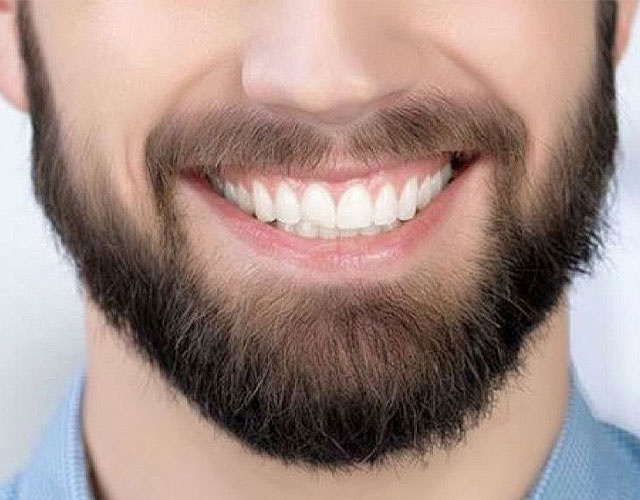What is Beard and Moustache Transplantation?
Hair follicles from the scalp are transplanted to the beard and moustache for aesthetic purposes. Men with patchy facial hair or hair loss due to accident, surgery, or heredity undergo the treatment.
Follicular Unit Extraction removes donor hair follicles (FUE). After careful transplantation, the follicles are deliberately implanted to form a genuine beard or moustache.
The operation takes several hours and may cause swelling, redness, and pain for a few days. Most patients return to work and other activities within a week. Patients usually notice complete results a year after hair transplantation.

What are the advantages of Beard and Moustache Transplantation in Turkey?
Turkish Beard and Moustache Transplanting has several benefits:
- Skilled Surgeons: Turkey has numerous skilled Beard and Moustache Transplant surgeons. They use the newest methods and technology for maximum outcomes.
- Beard and Moustache Transplantation in Turkey is cheaper than elsewhere. Due to decreased living costs and high-quality medical services.
- State-of-the-Art Facilities: Turkey boasts various cutting-edge Beard and Moustache Transplantation facilities. These hospitals contain innovative technology and well-trained employees to give excellent treatment.
- Low Waiting Times: In Turkey, patients may commonly arrange their Beard and Moustache Transplanting surgeries within a few weeks after their first consultation. Patients may get therapy without waiting months.
- Tourism Opportunities: Turkey is a lovely nation with a rich history and culture. When healing following Beard and Moustache Transplantation, many patients take a trip.

What are the Beard and Moustache Transplantation options in Turkey?
Turkish Beard and Moustache Transplanting possibilities include:
- Follicular Unit Extraction (FUE): FUE is a minimally invasive procedure that transplants individual hair follicles from the donor to the recipient. This method is ideal for Beard and Moustache Transplanting since it places hair follicles precisely.
- Direct Hair Implantation (DHI): A specialised instrument implants hair follicles directly into the recipient region in this newer procedure. This method creates natural-looking beards and moustaches without scars.
- Synthetic Hair Implants: Beard and Moustache Transplantation may involve synthetic hair implants. High-quality synthetic fibres mimic real hair in these implants.
- Thrombocyte-Rich Plasma (Plasmolifting) Therapy: Plasmolifting treatment uses a patient’s blood to develop hair. To promote hair growth, the patient’s blood is collected, processed to produce thrombocyte-rich plasma, then injected.
Who is a good candidate for Beard and Moustache Transplantation?
Men with patchy or thin facial hair or who have lost hair due to accident, surgery, or heredity are good Beard and Moustache Transplant candidates. The donor location (typically the scalp) should have healthy hair follicles for transplanting.
Applicants should be in excellent health with no underlying medical issues that might hinder the treatment or recovery. They should also have reasonable expectations for the treatment and follow post-operative care guidelines.
Beard and Moustache Transplanting results may take many months to completely grow in. Applicants must be patient and wait for the whole findings.
What should be done before Beard and Moustache Transplantation?
Patients must prepare for Beard and Moustache Transplantation:
- Consult with a competent hair transplant surgeon: Patients should meet with a trained hair transplant surgeon to discuss their requirements and aspirations. The surgeon may assess hair loss and recommend Beard and Moustache Transplantation.
- Smokers should quit two weeks before the operation. Smoking slows recovery and increases problems.
- Avoid alcohol and caffeine 24 hours before the surgery.
- Avoid blood-thinning medications: Patients should avoid aspirin for a week before the surgery. Some drugs may cause bleeding during and after surgery.
- Transportation: As patients cannot drive after surgery, they should plan for transportation to and from the treatment.
- Follow pre-operative instructions: Surgeons may advise patients to fast before surgery.
These tips may assist patients prepare for their Beard and Moustache Transplantation and get the best outcomes.

How is Beard and Moustache Transplantation performed?
Beard and Moustache Transplanting usually involves these steps:
- Local anaesthetic numbs the donor and recipient sites.
- Donor hair harvesting: Hair follicles are taken from the scalp. FUE or DHI is used.
- Recipient region preparation: Little incisions or holes are made to transplant hair follicles.
- Transplanting hair follicles: The surgeon will insert hair follicles at the right angle and direction for a realistic appearance.
- Post-operative care: The patient will get instructions for caring for the transplanted region. Using painkillers, avoiding specific items, and keeping the area clean and dry may help.
- Depending on hair loss and number of follicles implanted, the surgery might take several hours.
Each patient’s experience depends on their requirements and aspirations. Hair transplant surgeons may customise treatment plans and walk patients through the process.
Beard and Moustache Transplantation growth timeline.
Beard and Moustache Transplanting growth times vary. Transplanted hair grows in stages:
- First 2–3 weeks post-op: Transplanted areas may be red, swollen, and sensitive. To recuperate, patients may require pain medication and rest.
- First 2–3 months post-op: The transplanted hairs will relax and may fall out. This is normal.
- Months 3-6 post-op: New hairs will sprout in the transplanted location. The hair may start to grow, although it may be thin and sparse.
- Months 6-12 post-op: The transplanted hairs will grow and thicken. This should significantly increase face hair density and look.
- After 12 months, transplanted hairs should be completely grown in and patients should have obtained their desired outcome.
Age, genetics, and hair loss severity affect the growth timeframe. Patients should be patient and follow post-operative care guidelines for optimal outcomes.

How long does Beard and Moustache Transplantation take in Turkey?
The length of Beard and Moustache Transplantation in Turkey depends on the quantity of hair follicles implanted. The operation usually takes 2–6 hours. The surgeon’s hair transplant method and the patient’s objectives determine the procedure’s duration.
If they want greater covering or lose more hair, they may require further treatments. A skilled Turkish hair transplant surgeon can customise a treatment plan and offer patients a clearer sense of how long the surgery would take.
How long does Beard and Moustache Transplantation last?
Beard and Moustache Transplanting permanently fixes facial hair loss. Hairs from the donor location (typically the scalp) are transplanted (male pattern baldness). Hence, transplanted hairs should grow and act like normal face hair.
The transplanted hairs are permanent, however androgenetic alopecia may decrease or lose the patient’s natural hair. Patients may require more treatments to retain the desired look. Based on the patient’s wants and objectives, a Turkish hair transplant surgeon may estimate the results’ lifespan.
What should be done after Beard and Moustache Transplantation treatment?
To get the finest results from Beard and Moustache Transplantation, patients must follow post-op recommendations. Examples:
- Clean and dry: Patients should avoid getting the transplanted region wet for at least 72 hours following the operation. Avoid rubbing or scratching the area to avoid infection.
- Following instructions: The surgeon may give painkillers or antibiotics to avoid infection. Use these drugs as prescribed.
- Avoiding vigorous activity: Patients should avoid severe exercise or activities that may sweat or rub the transplanted region for at least a week following the surgery.
- Avoiding specific products: Patients should avoid hair spray and gel for at least a week following the treatment.
- Following up with the surgeon: Patients must return to the clinic for follow-up sessions to assess healing and confirm that transplanted hairs are growing appropriately.
- Each patient’s experience depends on their requirements and aspirations. Turkey’s hair transplant surgeons may provide patients customized post-op treatment.
How many treatment sessions are needed for Beard and Moustache Transplantation?
Depending on the patient’s demands and transplanting extent, Beard and Moustache Transplantation may need many treatments. For people with mild to severe beard or moustache hair loss or thinning, one treatment usually works.
Patients with substantial hair loss or scars may need numerous procedures to attain the required density and natural look. Your surgeon will examine your hair loss pattern and offer the best treatment depending on your requirements to decide the number of sessions.
The method and quantity of hair transplanted might also affect therapy duration. A single treatment might take many hours and require several days of recuperation.
